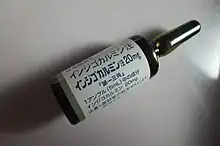Indigo carmine
 | |
 | |
| Names | |
|---|---|
| Preferred IUPAC name
Disodium [2(2′)E]-3,3′-dioxo-1,1′,3,3′-tetrahydro[2,2′-biindolylidene]-5,5′-disulfonate | |
| Other names
indigotine 5,5′-indigodisulfonic acid sodium salt Brilliant Indigo 4 G C.I. Acid Blue 74 C.I. 73015 CI Food Blue 1 FD&C Blue 2 Sicovit Indigotin 85 E132 indigotindisulfonate sodium | |
| Identifiers | |
CAS Number |
|
3D model (JSmol) |
|
| ChEBI | |
| ChEMBL | |
| ChemSpider | |
| DrugBank | |
| ECHA InfoCard | 100.011.572 |
| E number | E132 (colours) |
| KEGG | |
PubChem CID |
|
| UNII | |
CompTox Dashboard (EPA) |
|
InChI
| |
SMILES
| |
| Properties | |
Chemical formula |
C16H8N2Na2O8S2 |
| Molar mass | 466.36 g/mol |
| Appearance | purple solid |
| Melting point | >300 °C (572 °F) |
Solubility in water |
10 g/L (25 °C (77 °F)) |
| Hazards | |
| GHS labelling: | |
Pictograms |
 [1] [1] |
Signal word |
Warning |
Hazard statements |
H302[1] |
| NFPA 704 (fire diamond) | |
| Pharmacology | |
| V04CH02 (WHO) | |
| Legal status | |
Except where otherwise noted, data are given for materials in their standard state (at 25 °C [77 °F], 100 kPa).
Infobox references | |
| Clinical data | |
|---|---|
| Trade names | Bludigo |
| License data | |
| Identifiers | |
| E number | E132 (colours) |
| CompTox Dashboard (EPA) | |
| ECHA InfoCard | 100.011.572 |
Indigo carmine, or 5,5′-indigodisulfonic acid sodium salt, is an organic salt derived from indigo by aromatic sulfonation, which renders the compound soluble in water. It is approved for use as a food colorant in the U.S and E.U. to produce a blue color.[3][4] It has the E number E132. It is also a pH indicator.
Uses
| Indigo Carmine (pH indicator) | ||
| below pH 11.4 | above pH 13.0 | |
| 11.4 | ⇌ | 13.0 |

Indigo carmine in a 0.2% aqueous solution is blue at pH 11.4 and yellow at 13.0. Indigo carmine is also a redox indicator, turning yellow upon reduction. Another use is as a dissolved ozone indicator[5] through the conversion to isatin-5-sulfonic acid.[5] This reaction has been shown not to be specific to ozone, however: it also detects superoxide, an important distinction in cell physiology.[6] It is also used as a dye in the manufacturing of capsules.
Medical uses

Indigotindisulfonate sodium, sold under the brand name Bludigo, is used as a diagnostic dye during surgical procedures.[2] It is indicated for use as a visualization aid in the cystoscopic assessment of the integrity of the ureters in adults following urological and gynecological open, robotic, or endoscopic surgical procedures.[2][7] It was approved for medical use in the United States in July 2022.[2][7]
In obstetric surgery, indigo carmine solutions are sometimes employed to detect amniotic fluid leaks. In urologic surgery, intravenous injection of indigo carmine is often used to highlight portions of the urinary tract. The dye is filtered rapidly by the kidneys from the blood, and colors the urine blue. This enables structures of the urinary tract to be seen in the surgical field, and demonstrate if there is a leak. However, the dye can cause a potentially dangerous increase in blood pressure in some cases.[8]
Although not absorbed by the cells, indigo carmine stain, sprayed onto regions of interest, highlights the topography of the mucosal surface with its blue coloring. Generally used at a concentration around 0.2%, indigo carmine stain is useful as a screening method for diagnosing minute lesions, to differentiate between benign and malignant lesions, as well as to facilitate application of magnifying endoscopes to observe and analyze the surface structure of a lesion, delineate boundaries of early stage malignant lesions and estimate the invasion depth of cancer. It has been used to diagnose Barrett’s esophagus, evaluate villous atrophy, diagnose and discriminate polypoid and non-polypoid lesions in the colon, and diagnose gastric adenoma and cancer.[9]
References
- 1 2 "Indigo carmine". Sigma Aldrich. Retrieved 15 Feb 2022.
- 1 2 3 4 "Bludigo- indigotindisulfonate sodium injection". DailyMed. 7 November 2022. Retrieved 21 January 2023.
- ↑ Summary of Color Additives for Use in United States in Foods, Drugs, Cosmetics, and Medical Devices, Food and Drug Administration
- ↑ Current EU approved additives and their E Numbers, Food Standards Agency, 26 November 2010
- 1 2 Takeuchi K, Ibusuki T (March 1989). "Quantitative determination of aqueous-phase ozone by chemiluminescence using indigo-5,5'-disulfonate". Anal. Chem. 61 (6): 619–23. doi:10.1021/ac00181a025. PMID 2729594.
- ↑ Kettle AJ, Clark BM, Winterbourn CC (April 2004). "Superoxide converts indigo carmine to isatin sulfonic acid: implications for the hypothesis that neutrophils produce ozone". J. Biol. Chem. 279 (18): 18521–5. doi:10.1074/jbc.M400334200. PMID 14978029.
- 1 2 "NDA APPROVAL: Bludigo (indigotindisulfonate sodium) injection" (PDF). U.S. Food and Drug Administration.
 This article incorporates text from this source, which is in the public domain.
This article incorporates text from this source, which is in the public domain. - ↑ Craik JD, Khan D, Afifi R (January–February 2009). "The Safety of Intravenous Indigo Carmine to Assess Ureteric Patency During Transvaginal Uterosacral Suspension of the Vaginal Vault". Journal of Pelvic Medicine & Surgery. 15 (1): 11–15. doi:10.1097/SPV.0b013e3181986ace.
- ↑ Jang JY (November 2015). "The Past, Present, and Future of Image-Enhanced Endoscopy". Clinical Endoscopy. 48 (6): 466–475. doi:10.5946/ce.2015.48.6.466. PMC 4676674. PMID 26668791.
External links
- "Indigotindisulfonate sodium". Drug Information Portal. U.S. National Library of Medicine.
